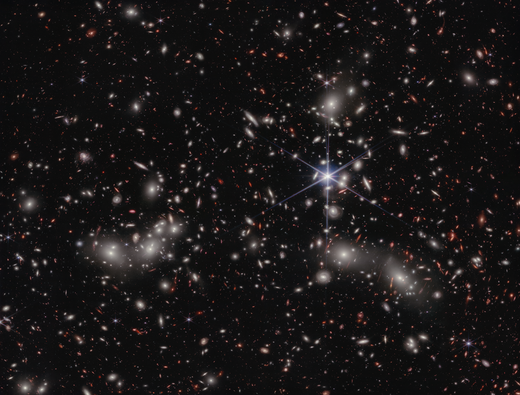 Pandora's Cluster, scientifically known as Abell 2744, is a celestial masterpiece that captivates the imagination with its ethereal beauty. Located approximately 4 billion light-years away from Earth, this remarkable galaxy cluster presents a visual spectacle, offering astronomers and space enthusiasts a glimpse into the stunning intricacies of our universe. In this article, we will explore the breathtaking beauty of Pandora's Cluster and unravel the secrets hidden within its cosmic tapestry. A Tapestry of Galaxies: Pandora's Cluster is a dynamic congregation of hundreds of galaxies, entwined in a cosmic dance of gravity and cosmic forces. This galactic tapestry is composed of various shapes, sizes, and colors, ranging from spiraling galaxies adorned with vibrant arms to elliptical galaxies with smooth, elongated structures. Each galaxy within the cluster has a story to tell, contributing to the overall visual allure of Pandora's Cluster. Cosmic Color Palette: One of the striking aspects of Pandora's Cluster is its rich and diverse color palette. The cluster's galaxies exhibit a mesmerizing array of hues, ranging from deep blues and vivid reds to golden yellows and serene greens. These colors are not mere artistic embellishments but instead provide valuable scientific insights into the cluster's composition, stellar populations, and evolutionary processes. By analyzing the colors of galaxies within Pandora's Cluster, astronomers can uncover clues about the ages, chemical compositions, and star formation histories of these cosmic entities. Gravitational Lensing: A Cosmic Mirage: Pandora's Cluster possesses an immense mass, which bends and distorts the fabric of space-time itself. This gravitational distortion gives rise to a phenomenon known as gravitational lensing. Just as a lens magnifies and distorts light, the gravitational lensing effect in Pandora's Cluster acts as a cosmic mirage, warping and magnifying the light emitted by background galaxies. The result is a breathtaking display of gravitational arcs and multiple images of distant galaxies, adding an enchanting allure to the cluster's visual appeal. Cosmic Collisions and Arcs of Light: Pandora's Cluster is the result of a colossal collision between at least four smaller galaxy clusters, an event that sparked a celestial symphony of cosmic interactions. These collisions generated shockwaves that rippled through the cluster, leading to the formation of dramatic arcs of light. These luminous arcs, resembling cosmic rainbows, are the product of gravitational lensing in action. The arcs trace the paths of light from galaxies located far beyond Pandora's Cluster, delicately curved and magnified by the cluster's gravitational pull. The result is a celestial spectacle, a visual testament to the dynamic and ever-evolving nature of our universe. The Dance of Dark Matter: Beyond its stunning visual features, Pandora's Cluster also provides a unique opportunity to study the enigmatic dark matter. Dark matter, an invisible substance that constitutes the majority of the universe's mass, plays a significant role in shaping the cosmic landscape. The gravitational effects of dark matter are evident within Pandora's Cluster, where its distribution can be inferred by observing the gravitational lensing phenomena and the motion of galaxies within the cluster. Through meticulous analysis and modeling, scientists gain valuable insights into the nature and properties of dark matter, enhancing our understanding of the fundamental forces that govern the cosmos. Pandora's Cluster is a true celestial masterpiece, an embodiment of cosmic beauty and scientific intrigue. Its captivating visual allure, vibrant colors, and gravitational lensing phenomena showcase the profound complexity and grandeur of our universe.
0 Comments
Leave a Reply. |
authorBryant Maxwell - Project Communications Officer Archives
November 2023
Categories |
- Home
- Design Your Habitat
-
Contests
- NASA Children's Art Contest
- Science in Action NASA Earth Comic Strip Contest >
- Moon Youth Art Competition Gallery
- Project Mars
- New Horizons Ultima Art
- STEAM Your Science >
- 2017 Eclipse Over Houston >
- Humans In Space Art- Video Challenge >
- Humans In Space Art - Youth Competition >
- Humans In Space Art- CAFE >
- Events
- Services
- Community
- Donate
- Subscribe
- Contact
- Home
- Design Your Habitat
-
Contests
- NASA Children's Art Contest
- Science in Action NASA Earth Comic Strip Contest >
- Moon Youth Art Competition Gallery
- Project Mars
- New Horizons Ultima Art
- STEAM Your Science >
- 2017 Eclipse Over Houston >
- Humans In Space Art- Video Challenge >
- Humans In Space Art - Youth Competition >
- Humans In Space Art- CAFE >
- Events
- Services
- Community
- Donate
- Subscribe
- Contact

 RSS Feed
RSS Feed